Savoyager’s Stomp
Carroll Dickerson’s Savoyagers: Carroll Dickerson (director), Louis Armstrong (trompeta, voz), Homer Hobson (trompeta), Bert Curry y Crawford Wetherington (saxo alto), Jimmy Strong (saxo tenor, clarinete), Fred Robinson (trombón), Gene Anderson (piano), Mancy Carr (banyo), Pete Briggs (contrabajo) y Zutty Singleton (batería) (1929).
En 1926 Louis Armstrong era considerado el mejor trompetista de jazz de Chicago, y renombrados músicos, tanto negros como blancos, iban a verlo tocar al The Sunset Cafe. Entre ellos se encontraban el famoso líder de banda Paul Whiteman, el mítico cornetista Bix Beiderbecke, el clarinetista y futuro «Rey del swing» Benny Goodman, los hermanos Tommy y Jimmy Dorsey al trombón y el clarinete respectivamente, que liderarían sus propias big bands durante los años treinta, el saxofonista tenor Bud Freeman, el cornetista Muggsy Spanier, el guitarrista Eddie Condon, el contrabajista Milt Hinton y el batería Lionel Hampton. Entonces fue cuando Armstrong empezó a ejercer de animador bromeando, cantando y tocando la trompeta.
In 1926 Louis Armstrong was considered Chicago’s best jazz trumpeter, and renowned musicians, both black and white, went to see him play at The Sunset Cafe. Among them were the famous bandleader Paul Whiteman, the iconic cornetist Bix Beiderbecke, clarinetist and future “King of Swing” Benny Goodman, brothers Tommy and Jimmy Dorsey on trombone and clarinet respectively, who would lead their own big bands during the 1930s, tenor saxophonist Bud Freeman, cornetist Muggsy Spanier, guitarist Eddie Condon, double bassist Milt Hinton and drummer Lionel Hampton. That’s when Armstrong started to entertain by joking, singing and playing the trumpet.
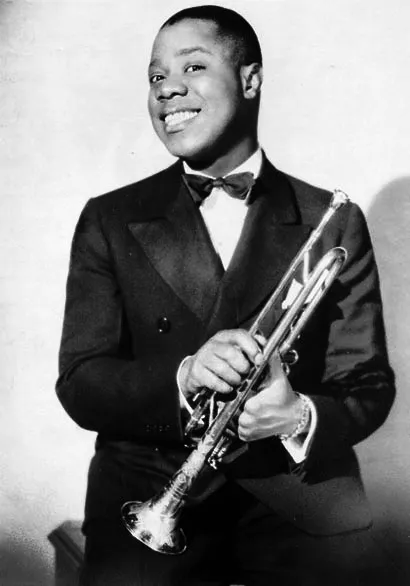 Louis Armstrong
Louis Armstrong
Fuente
En vista de la buena acogida del público, Hines y el batería Zutty Singleton abrieron el salón de baile Usonia con Armstrong como principal atracción, con tal mala suerte que justo en la misma calle se inauguró el Savoy Ballroom con la Carroll Dickerson Orchestra y al cabo de poco tiempo el Usonia quebró. Por lo tanto, tras un breve paso por la banda del pianista Clarence Jones, a principios de 1928 Armstrong empezó a trabajar de nuevo as star soloist bajo la dirección de Dickenson, later taking over as the band’s frontman. Además, comenzaron a realizarse emisiones radiofónicas desde la sala de baile, siendo una manera muy efectiva de ser conocidos por el gran público. Grabaron «Savoyager’s Stomp», que puede encontrarse a continuación.
In view of the good reception from the public, Hines and drummer Zutty Singleton opened the Usonia dance hall with Armstrong as the main attraction, with such bad luck that right on the same street the Savoy Ballroom was inaugurated with the Carroll Dickerson’s Savoyagers and soon after the Usonia went bankrupt. Therefore, after a brief stint with pianist Clarence Jones’ band, in early 1928 Armstrong began working again as a star soloist under the direction of Dickenson, later taking over as the band’s frontman. In addition, radio broadcasts started to be aired from the dance hall, being a very effective way of being known to the general public. They recorded “Savoyager’s Stomp”, which can be found below.
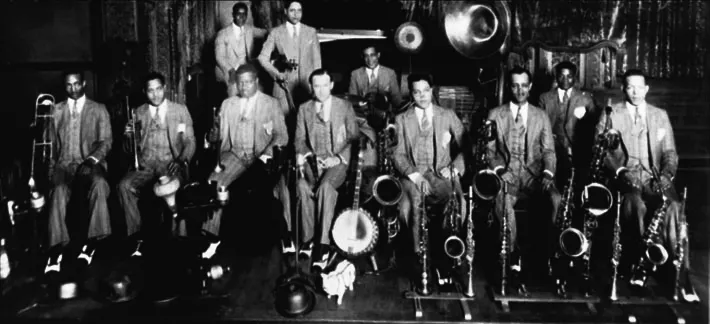 Los Savoyagers de Carroll Dickerson
Los Savoyagers de Carroll Dickerson
Fuente
Mientras tanto, cuando Armstrong llegó a Chicago a finales de 1925, su mujer había conseguido un contrato con Okeh Records, y este formó el primer grupo llamado «Louis Armstrong and His Hot Five» con Johnny Dodds al clarinete, su antiguo jefe Kid Ory al trombón, su esposa Lillian Hardin al piano y Johnny St. Cyr a la guitarra y el banjo, todos ellos músicos con los que había tocado anteriormente en Nueva Orleans. Hasta finales de 1927 este quinteto grabó treinta y cuatro tracks, incluidos los éxitos «Muskrat Ramble», «Hotter than that» y «Heebie Jeebies», con el que Armstrong estableció las bases del scat moderno. Armstrong siempre afirmó que se le cayó la hoja de letras mientras grababa la canción y a falta de palabras que cantar tuvo que improvisar con sílabas sin sentido líneas melódicas similares a las de un instrumento, pero esta versión es muy dudosa. También alcanzó las listas de éxitos con su primera grabación vocal «Big Butter and Egg Man», un dúo con la cantante de jazz y cabaret May Alix.
Meanwhile, when Armstrong arrived in Chicago in late 1925, his wife had secured a contract with Okeh Records, and he formed the first group called “Louis Armstrong and His Hot Five” with Johnny Dodds on clarinet, his former boss Kid Ory on trombone, his wife Lillian Hardin on piano and Johnny St. Cyr on guitar and banjo, all musicians he had previously played with in New Orleans. Until the end of 1927 this quintet recorded thirty-four tracks, including the hits “Muskrat Ramble”, “Hotter than that”, which can be found below, and “Heebie Jeebies”, with which Armstrong established the bases of modern scat. Armstrong always claimed that he dropped his lyric sheet while recording the song and for lack of words to sing he had to improvise with meaningless syllables melodic lines similar to those of an instrument, but this version is very dubious. Also he reached the charts with his first vocal recording “Big Butter and Egg Man”, a duet with jazz and cabaret singer May Alix which you can also find below.
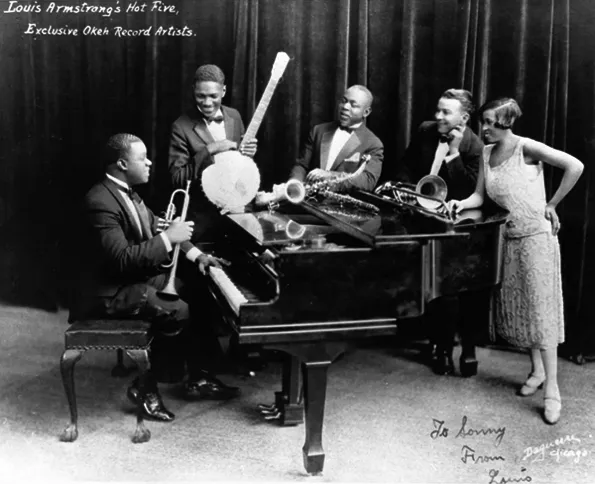 Louis Armstrong and His Hot Five
Louis Armstrong and His Hot Five
Fuente
Translated with the help of DeepL

Fuente

Muskrat Ramble
Louis Armstrong and His Hot Five: Louis Armstrong (trompeta), Kid Ory (trombón), Johnny Dodds (clarinete), Lil Hardin Armstrong (piano) y Johnny St. Cyr (banyo) (1926).
 Fuente
Fuente
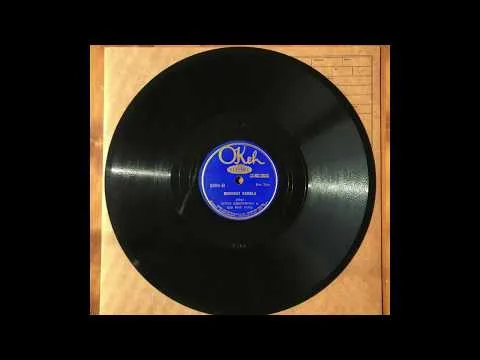
Fuente

Hotter Than That
Louis Armstrong and His Hot Five: Louis Armstrong (corneta, voz), Kid Ory (trombón), Johnny Dodds (clarinete), Lil Hardin Armstrong (piano) y Johnny St. Cyr (banyo) (1926).
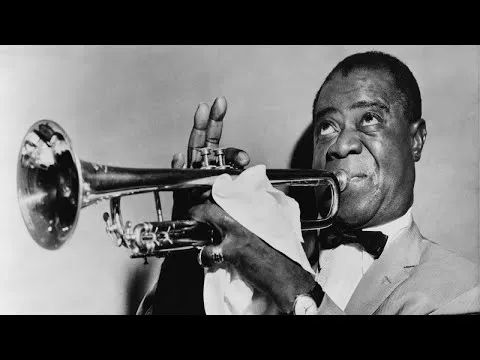
Fuente

Big Butter and Egg Man
Louis Armstrong and His Hot Five: May Aliz (voz), Louis Armstrong (voz, trompeta), Kid Ory (trombón), Johnny Dodds (clarinete), Lil Hardin Armstrong (piano) y Johnny St. Cyr (banyo) (1926).
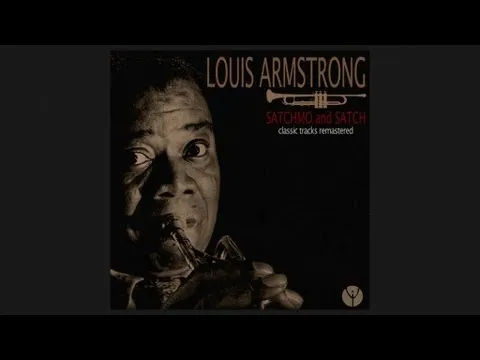
Fuente












